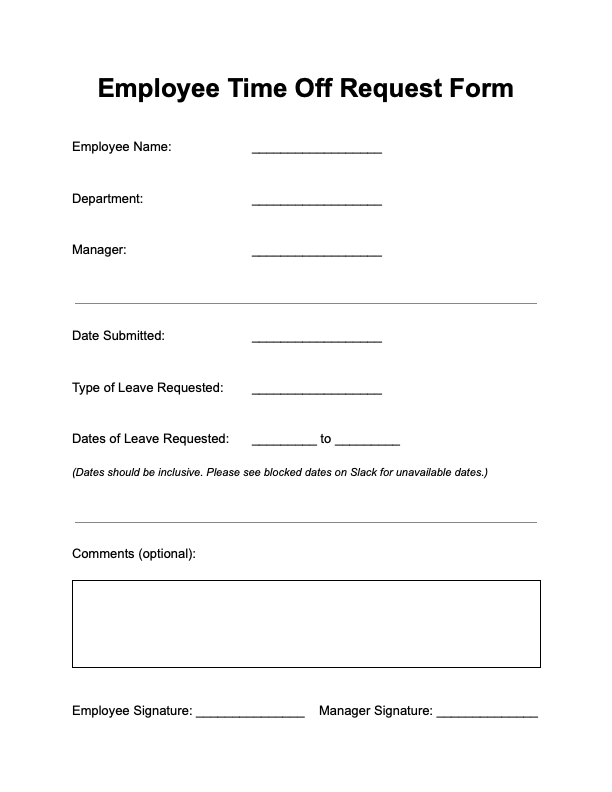November 18, 2024
Presenteeism: The $150 Billion Problem for Modern Businesses
What if your organization is losing more productive hours from employees showing up than from those staying h...
A key part of managing vacation time, or other types of leave, is the process for how employees ask for time off. This should be done with a clear and easy-to-follow vacation request form.
Getting this part right makes it much easier to manage time off requests. You’ll have all the information you need to review and file the request, and there will be less confusion regarding time off requests.
This post will explain what your employee vacation request form should look like, before sharing a request form template you can use in your business.
Your vacation request form needs to include certain details. Too much information will make it overly complicated, but you need a few things to allow managers or the human resources department to properly manage PTO requests.
Your form should include:
Self-explanatory. You need the name of the employee the request is for.
The dates that the employee wishes to take off. Generally the dates are inclusive – meaning if, for example, someone asks for January 1st-15th off, their next working day (or available day) would be the 16th.
Make sure you make this clear to staff. You may even want to indicate the day they come back, to make it even more obvious and avoid any confusion.
You need some way to track the date on which the leave request was submitted, which could be important if you have two clashing PTO requests and need to decline one, or in case there are any issues with forms being lost or misplaced.
If your time off request process is digital (e.g. sending requests through email or Slack), you may not need this, as it’s likely already built into the system.
You need to know what type of leave is being requested – vacation, sick leave, parental leave, for example.
Learn more: different leave types to consider offering in your business.
Finally, have an additional space for the employee to leave any other comments they see fit.
What you should NOT do is require an explanation when someone asks for leave. Generally, if someone has the leave available, and they follow the rules (i.e. not asking for time off in too short notice), there’s no explanation necessary.
Doing so violates the employee’s privacy, and sets a culture where people feel they need to justify taking their vacation days, which you don’t want.
The exceptions may be in the case of sick leave or parental leave, if the employee needs to provide a medical certificate or proof from a doctor. But in most cases, as long as they comply with your time off request policy, you shouldn’t pry and ask unnecessary questions.
Make it clear to employees to fill out all the relevant information whenever they request time off, to ensure no delays in handling their request.
Here are some more things you should think about, related to your time off request form and process. Following these best practices will help ensure you have a smooth vacation/leave management system, which keeps employees happy and doesn’t result in lost productivity when key staff are absent.
Streamline your process by requiring that employees request leave the same way every time.
It’s hard to keep track when you have time off requests sent through all kinds of different channels. Whether this is an email to their manager, or through a leave tracking app, make it the standard operating procedure.
It’s best to do everything digitally. Paper forms get lost, the information provided on them can be unclear.
Digital provides a clear trail to follow – when the request was submitted, who it was submitted to, when the response was sent. It results in much less confusion or accusations of unfairness.
Clearly communicate to everyone how they should request time off. Don’t leave any room for confusion.
It should be part of your orientation/onboarding process, as well as in your employee handbook.
If there are dates when you can’t afford to let people go on leave, like a busy time of the year for your company, black these out and let everyone know that there will be no time off approved over these dates.
It’s best to make this clear up front, before you get employees organizing vacations on these dates only to find their leave won’t be approved.
Finally, make sure you’re adequately tracking all approved vacations. Don’t let it be a rude surprise when you turn up one day to find a key person’s vacation just started.
Make sure it’s part of the process whenever someone submits a request form to add it to your leave calendar. Better yet if you use a vacation tracking software like Flamingo, which automatically does this for you.

Here’s a sample you can use for inspiration for your company’s vacation request form:

Click below to get a Google Docs time off request form template sent to your email. Just copy and paste or save into your own account, and edit where necessary to fit your business.
Get the Vacation Request Form Template
Vacation request forms are a vital part of any company’s leave management system. Time off request forms give you a streamlined way for people to ask for leave, and make sure that managers or HR have all the information they need to approve or deny the request.
Make sure paid time off doesn’t hurt productivity in your team, so you can allow your staff members to get the rest and recovery they need to shine.
Flamingo® makes managing your team’s paid time off a breeze.